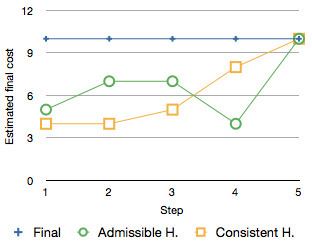 | ||
In the study of path-finding problems in artificial intelligence, a heuristic function is said to be consistent, or monotone, if its estimate is always less than or equal to the estimated distance from any neighboring vertex to the goal, plus the step cost of reaching that neighbor.
Formally, for every node N and each successor P of N, the estimated cost of reaching the goal from N is no greater than the step cost of getting to P plus the estimated cost of reaching the goal from P. That is:
where
A consistent heuristic is also admissible, i.e. it never overestimates the cost of reaching the goal (the opposite however is not always true!). This is proved by induction on
making it admissible. (
However, an admissible heuristic
(Known as the pathmax equation.)
Consequences of monotonicity
Consistent heuristics are called monotone because the estimated final cost of a partial solution,
In the A* search algorithm, using a consistent heuristic means that once a node is expanded, the cost by which it was reached is the lowest possible, under the same conditions that Dijkstra's algorithm requires in solving the shortest path problem (no negative cost cycles). In fact, if the search graph is given cost
